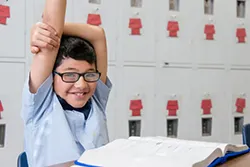One of the greatest teachers I’ve ever known taught me the importance of encouragement —and its relationship to motivation—in a grammar school classroom. She embedded into each day moments of praise and celebration of the good things students were learning. Mind you, this wasn’t just a baseless reward for everyone who happened to be present. Rather, it was truly her noticing and affirming the good thinking, habit formation and bits of learning that were taking place in the moment. The items she acknowledged were often very small successful steps in a much longer process.
For example, one day I watched her teach a briskly paced Shurley Grammar class. As soon as the class completed one sentence correctly, she said two words: “Yee haw!” On cue, the class responded in unison with imaginary lassos flying through the air and a loud cry of “Yee haw.” They moved to the next sentence and diagrammed it quickly, with an intense level of attention. Like throwing a soggy tennis ball for a dog to fetch, her words set the students off on the next task with enthusiasm. The positive feedback that she gave—not only at the end of a task, but also along the way—helped students build a sense of the importance of work itself to the result, and a sense of themselves as competent to reach that final result.
These days, I find myself working more often with small groups or individual students rather than whole classes. But this principle of embedded celebration of small successes stands up as a great way to build motivation and confidence. For example, I worked recently with a group of students on reading comprehension, a group not of strugglers, but of above-average students. These young folks have always found school easy, and their successes are expected. With them, I celebrate not just their correct answers, but their ability to revisit and analyze their incorrect answers. As they figure out what they missed the first time, true learning takes place.
I also had the privilege of working with a student struggling with beginning reading. Her efforts were halting, but we’ve been working together long enough for me to begin to see some success. I couldn’t help but notice that sounding out words was becoming easier for her because we had worked and practiced. Simply drawing her attention to the fact that she had improved made her beam, as she realized that her work had paid off. Instead of thinking that she couldn’t move forward, she began to know her own abilities. Her motivation and perseverance increased dramatically.
This points to the fact that struggle in the life of a child is not something to be avoided. Nearly all children will struggle with something, but with the appropriate effort and encouragement they can overcome it. When teachers lead students to see authentic improvement, they have the opportunity to see themselves as achievers. In many cases it is as though they stand outside of themselves and see themselves objectively as successful. This makes them resilient in life’s next struggle that will surely confront them. Thus, it is important that we neither avoid struggle, nor neglect to encourage students when real progress has occurred.
When you run on a treadmill, you go, quite literally, nowhere, unless you set your goals in speed, distance or fitness and move towards them. Children can also eliminate that feeling of going nowhere when goals are set before them, and their progress is made obvious to them. As parents and teachers, we can help students build skills, motivation, and confidence by noticing every small step and celebrating success all along the way. YEE HAW!





























